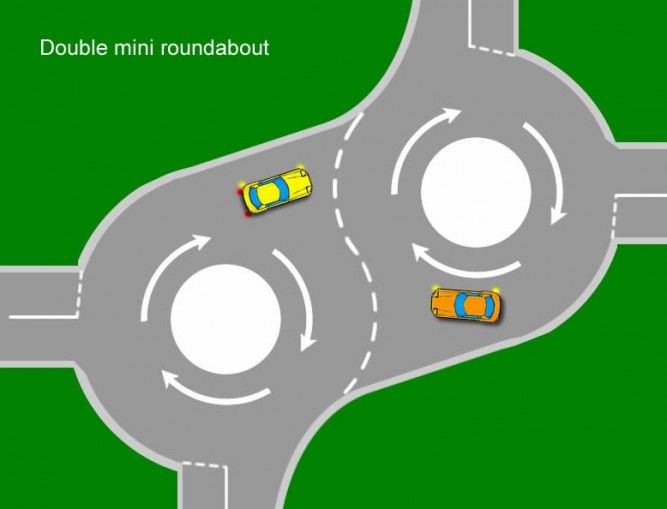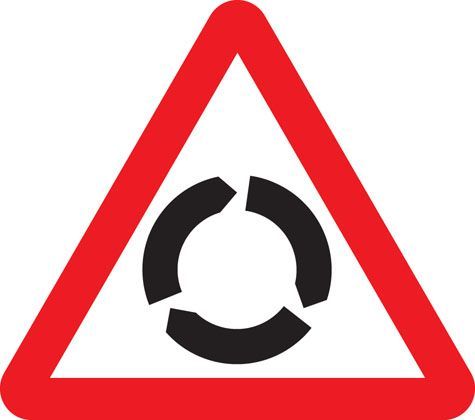Dealing With Roundabouts
Roundabouts In The UK
Roundabouts in the UK
The Purpose of roundabouts in the UK is to keep free flow of traffic. Being able to identify roundabouts, know which lane you need and how to deal with roundabouts will help you become a better driver and driving instructor.
Traffic approaching from your right have priority so you must give way to any road users approaching from your right.
How to Identify Roundabout
You can identify roundabout with the road signs, road marking and roundabout layout. Look for all the information available on approach to roundabout including road signs, road markings, traffic signs. Identify your exit well before you reach the roundabout so you can choose the correct lane in good time.
SEE OUR 2 MINUTE TUTORIAL ON ROUNDABOUTS
Identifying A Roundabout
The easiest way to identify a roundabout is by spotting the road signs early as possible.
The most common roadsign to identify an upcoming roundabout is the triangle one pictured on the right.
The arrows signify the direction of travel, showing that traffic is going to be travelling in an anti-clockwise direction
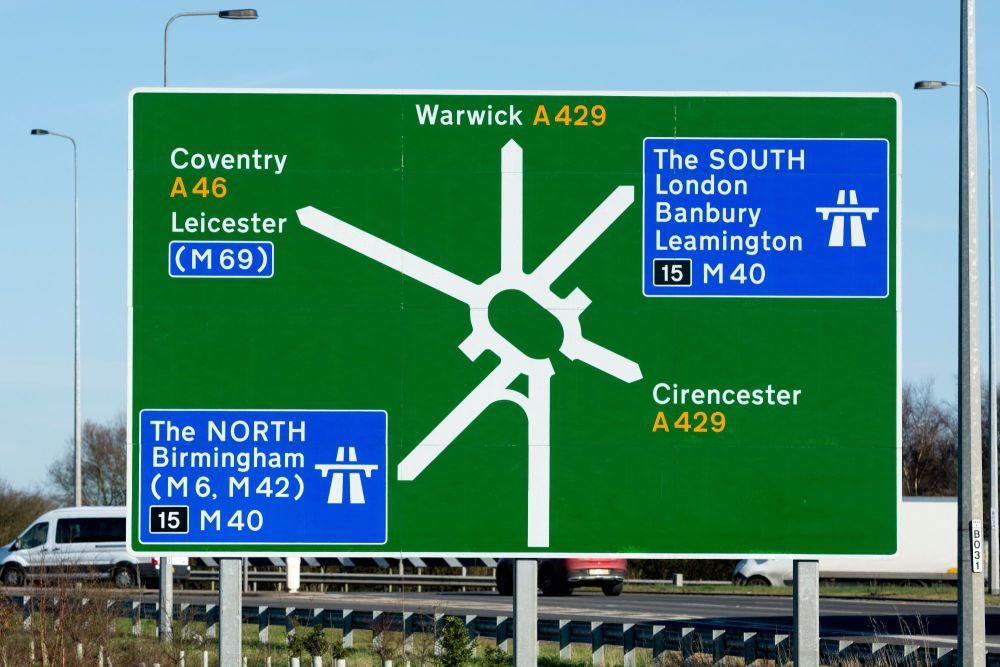
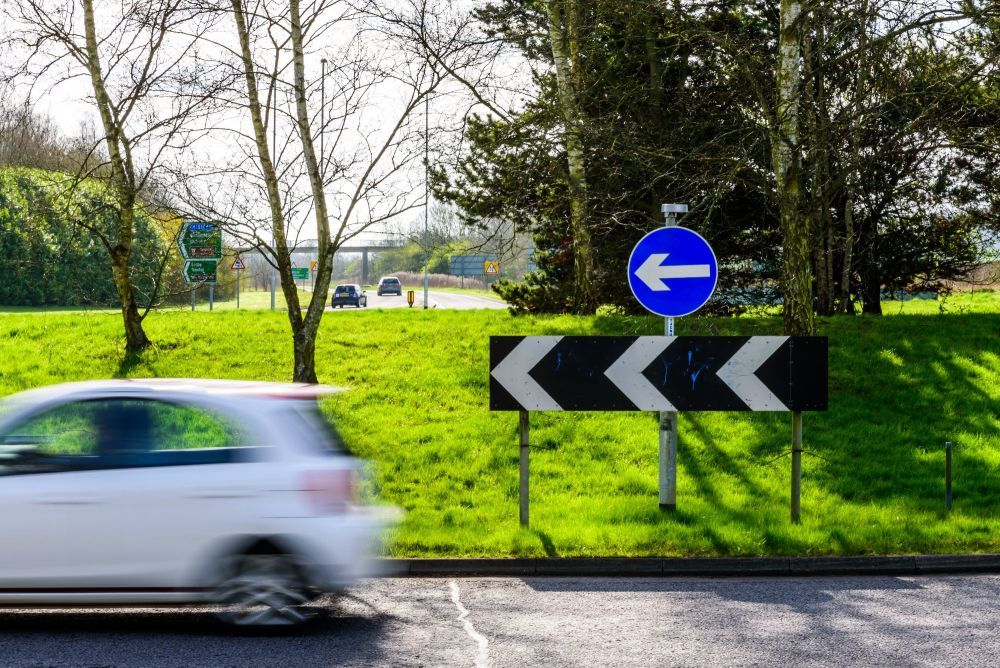
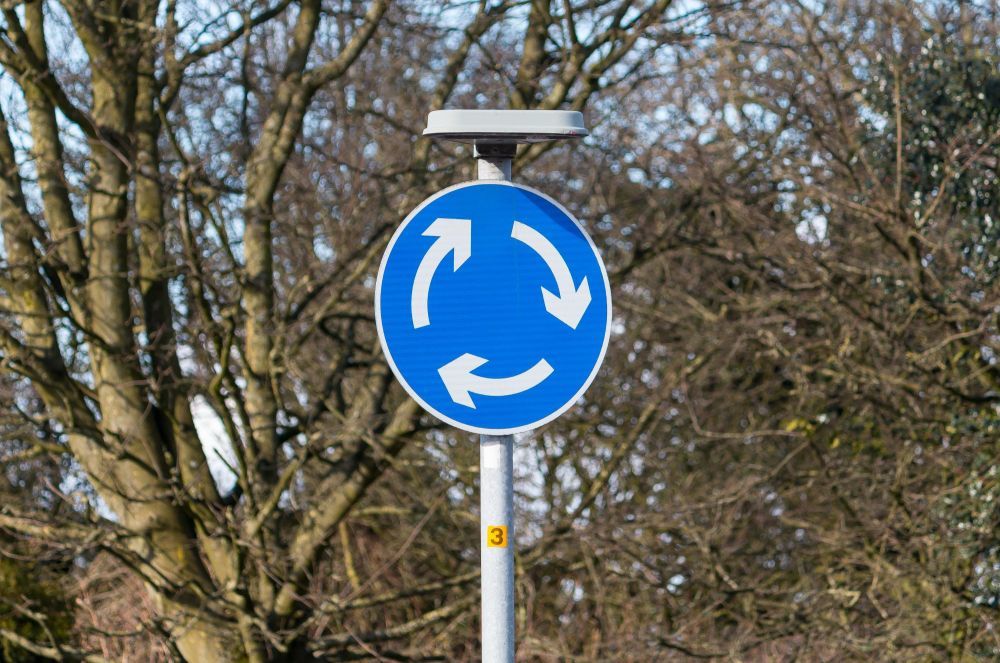
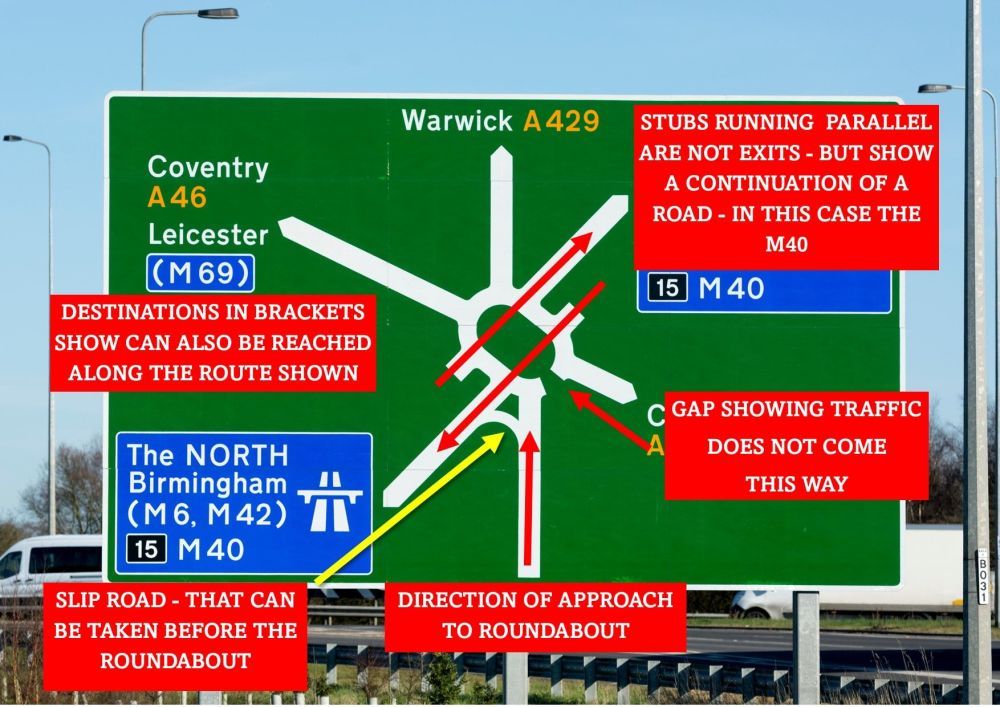
Reading Roundabout Signs
On approaching a roundabout take notice and act on all the information available to you, including traffic signs, traffic lights and lane markings which direct you into the correct lane. You should
- use Mirrors – Signal – Manoeuvre at all stages
- decide as early as possible which exit you need to take
- give an appropriate signal (see Rule 186, below). Time your signals so as not to confuse other road users
- get into the correct lane
- adjust your speed and position to fit in with traffic conditions
- be aware of the speed and position of all the road users around you.
Give Way To The Right
With roundabouts, we only give way to traffic from the right, unless the road markings say differently.
So we need to know how to choose a safe gap.
If we think of the roundabout as a clock face, if the car coming around is at, or before, the 3 O'clock position, then we have time to go
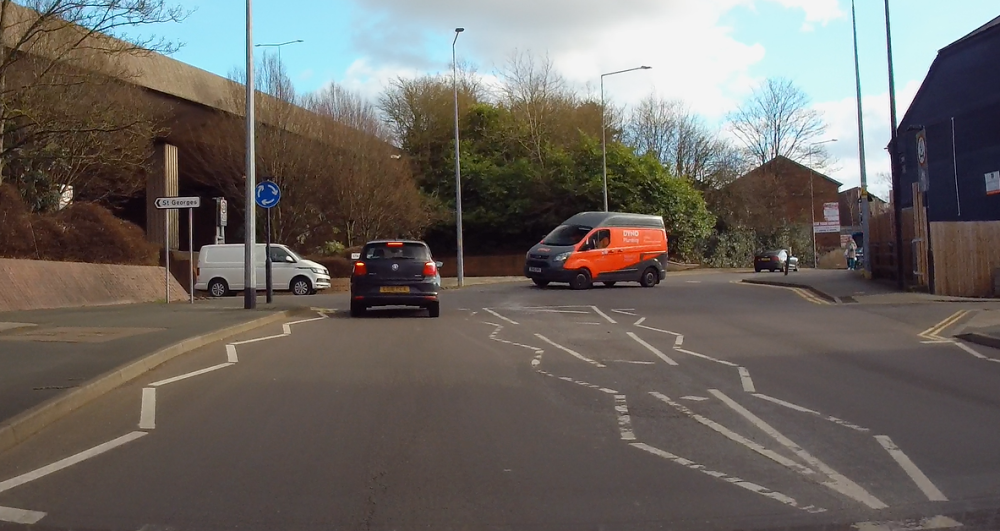
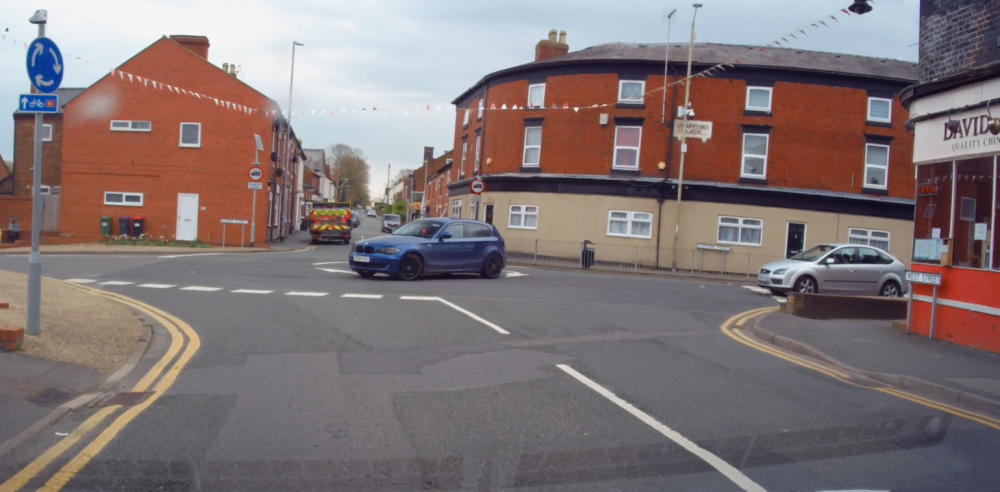
Roundabout - Open Or Closed View?
As with junctions we need to see if the roundabout is an open or closed view
A Closed view means theres buildings, bushes or brickwork that stops us seeing what is coming towards the roundabout and how quickly.
Therefore we need to come upto it, stop and make sure that its clear.
Roundabouts - 3 O'clock Position
Think of a roundabout as a clock face - 3,6,9 and 12.
If the car coming around is after the 3 oclock position
Then its better to wait for it to pass.
Or to exit the roundabout
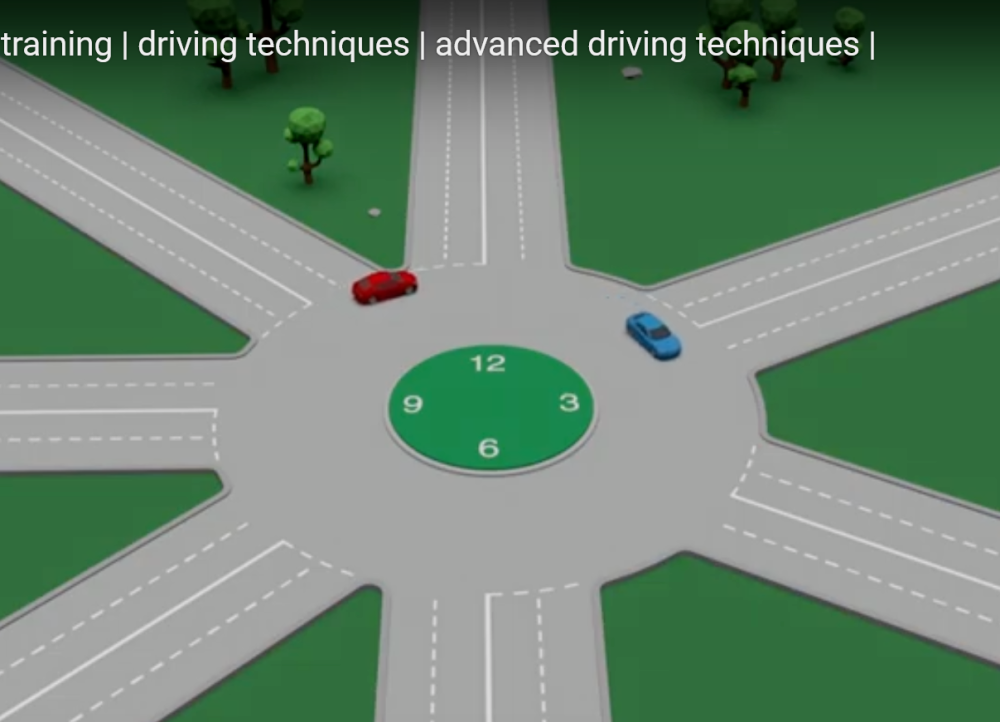
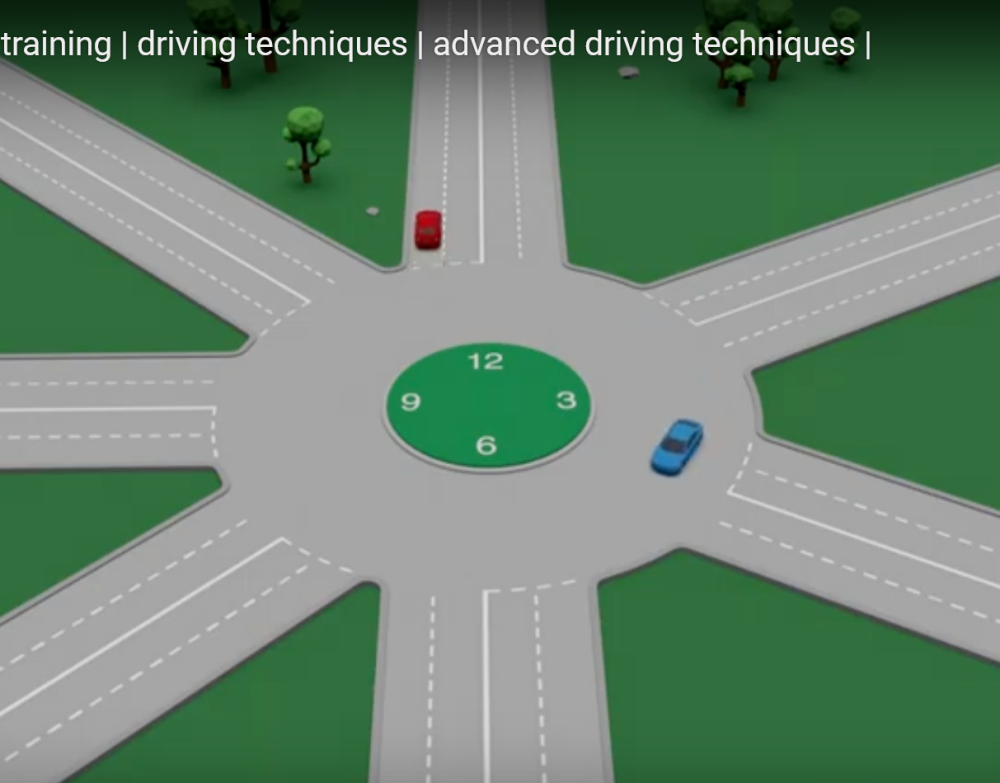
Roundabouts - After 3 o'clock Position
If the car coming around is after the 3 oclock position
Then its better to wait for it to pass.
Or to exit the roundabout
Roundabouts - Deciding Which Lane To Use
The easiest way to deal with roundabouts is to think of it as a clock.
What you then do is split it down the middle.
If the exit that you need is at 12 o'clock or before, you use the left hand lane.
If the exit you need is AFTER 12 o'clock, then you use the RIGHT hand lane.
Unless the road markings and signs say differently
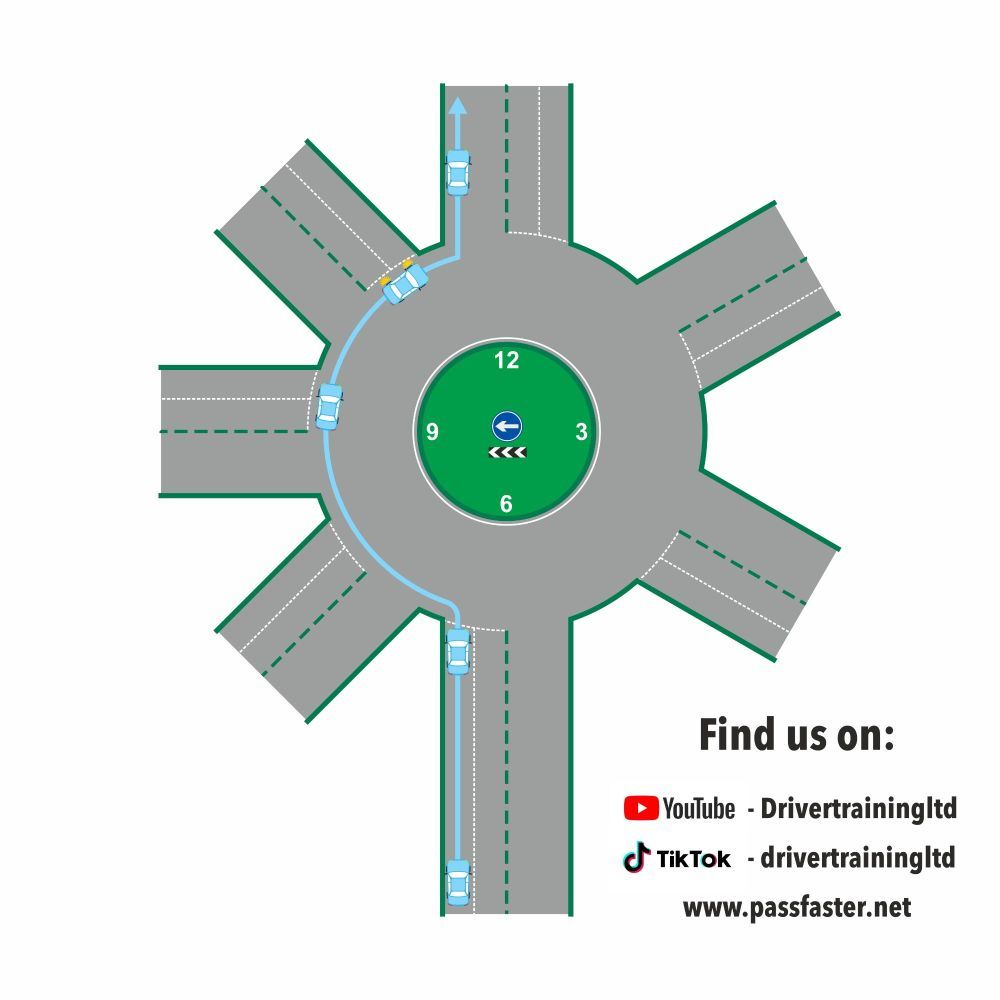
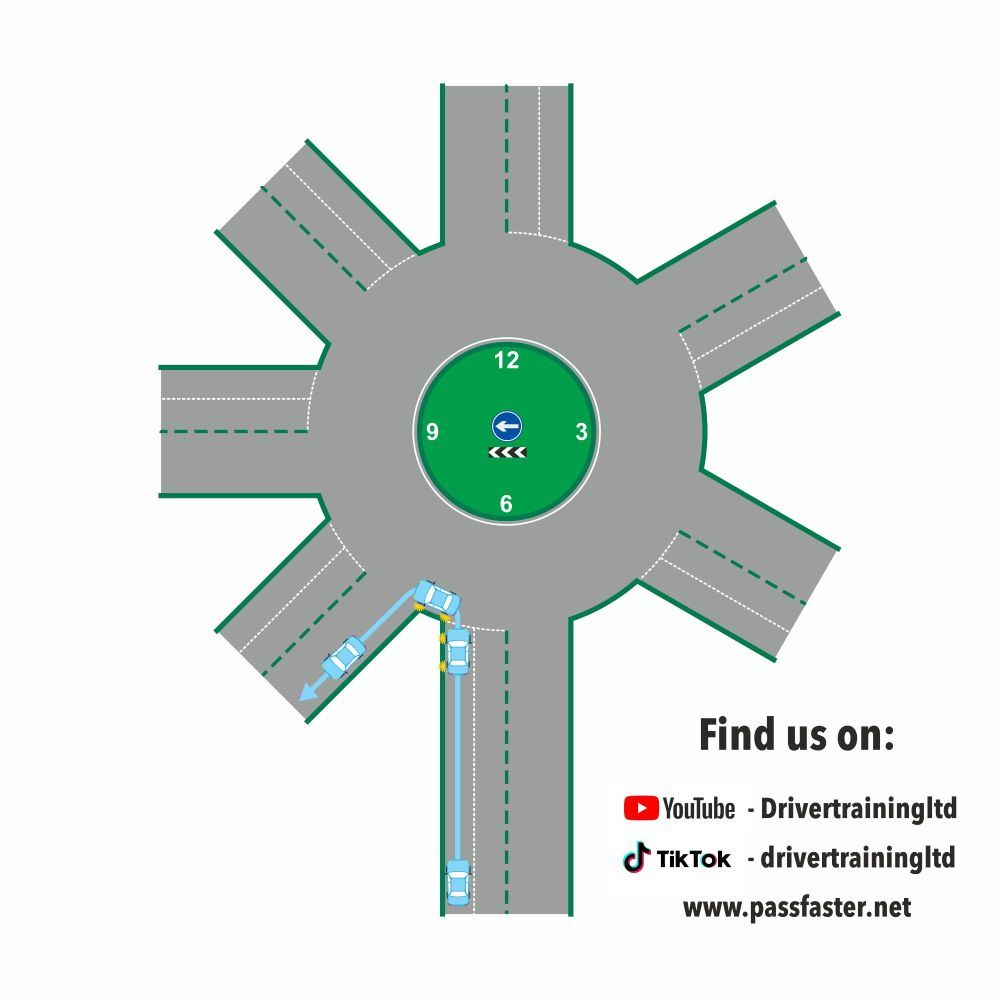
Roundabouts - First Exit
Because the first exit is before 12 o'clock, we use the left hand on approach.
We check the centre and left mirror, signal left and then follow it around
Roundabouts - 2nd Exit on Left
With this exit, we approach in the left hand lane, we keep in the left hand lane, and once we are half way past the first exit, we do centre and left mirror, signal left and then come off at exit number 2.
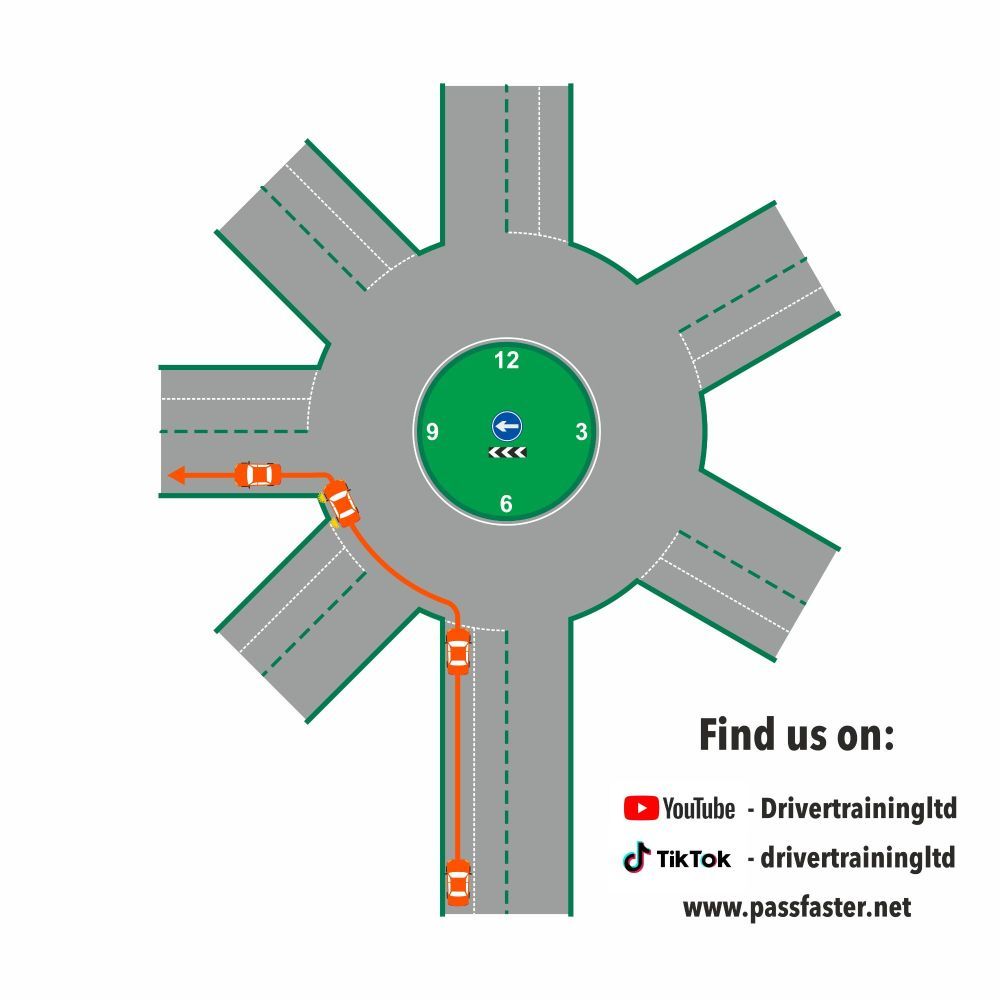
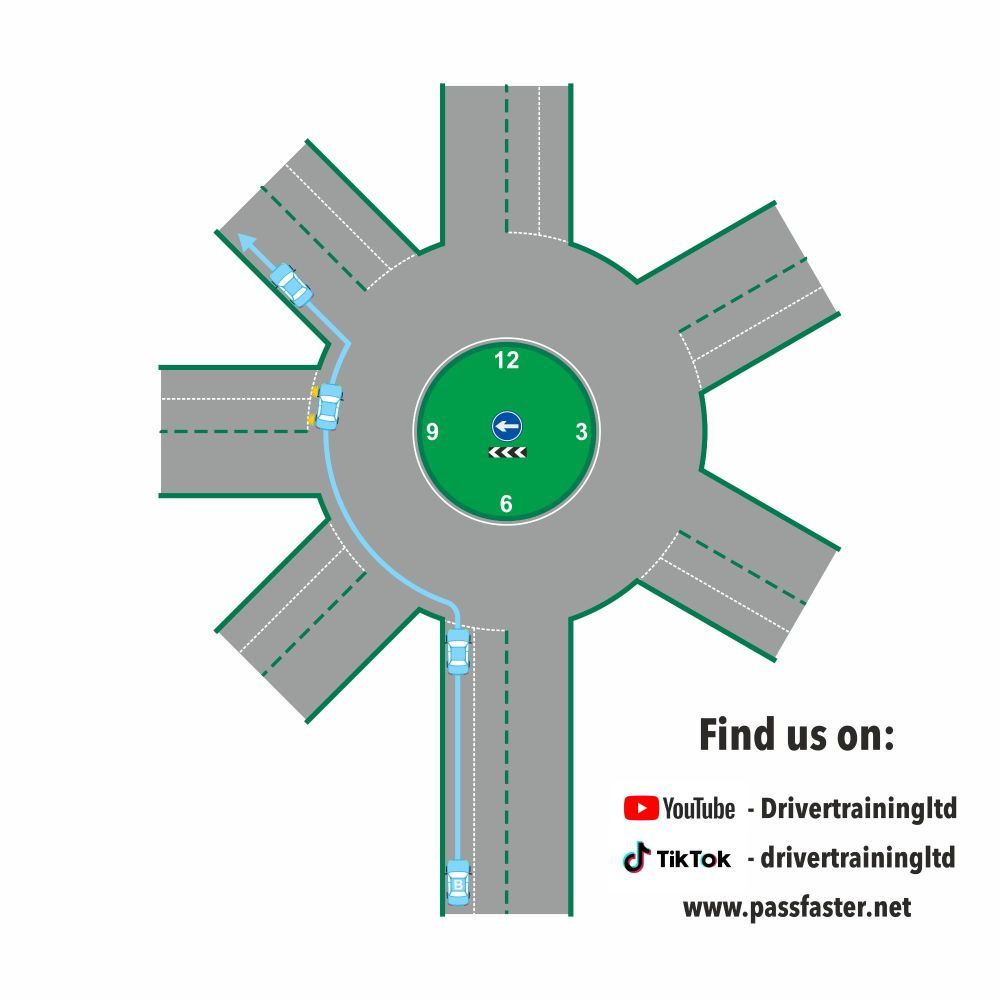
Roundabouts - 3rd Exit On The Left
On this example, 3rd exit is again, before 12 oclock, so we approach in the left hand lane, we follow the left hand lane around, and count the exits, and once we are halfway past exit number two, we check the centre and left mirror then signal left and come off at exit number three.
Roundabouts - Straight Ahead 4th Exit
Straight Ahead 1st exit - straight ahead 2nd exit - straight ahead 3rd exit
The number of the exit doesn't really matter - the key phrase is
"Straight Ahead" - So we know its at the 12 o'clock position - so left laneunless the road markings say other.
On this example 4th exit is at 12 o'clock so we still use the left lane on approach, we follow the left lane around, and we count the exits around. Half way past the third exit we do centre and left mirror and signal left to come off at the fourth exit.
Although it is straight ahead, you still need to signal left to exit the roundabout, so any pedestrians waiting to cross know where you are going and any oncoming traffic can tell where you are heading.
You know that you're going straight ahead, but how many times do we see cars with no signals on roundabouts and nobody has a clue where they are going.

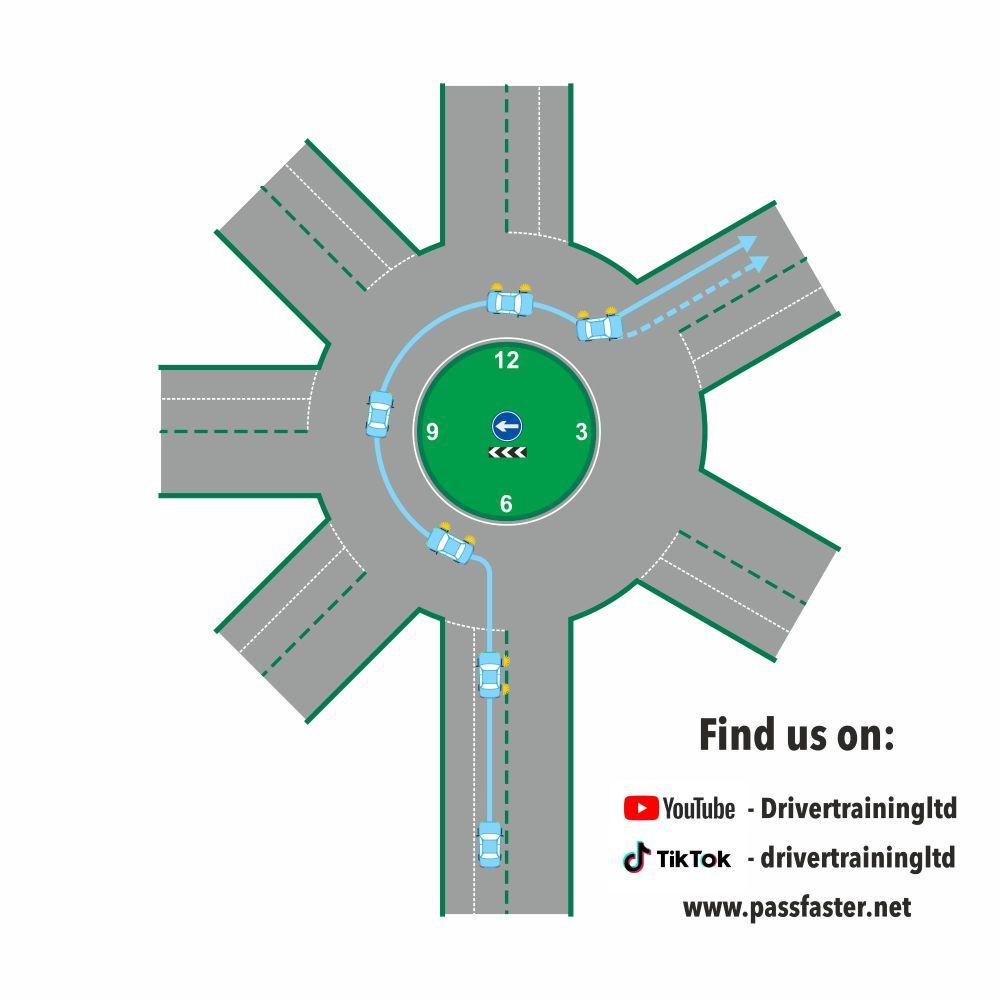
Roundabouts - Right 5th Exit
Right 5th Exit - Right 2nd Exit - Right 3rd Exit
The number of the exit is not the main thing here!
Its the fact that the direction is "Go Right" - This means that the exit is After 12 o'clock!
Because this exit is AFTER 12 oclock, on approach, you need to check the centre and RIGHT mirror, signal right and then get into the right hand lane.
Keep the right signal on, this lets everyone know that you are going all the way around the roundabout.
We go across to the roundabout and stick closely to the roundabout all the way around. We count the exits and half way past exit number four, we check the centre and left mirror and signal left.
This lets everyone know that we are coming off at the next exit, then we drift across towards the left kerb. This way we show where we are heading and it stops vehicles thinking we are carrying on around and then trying to under take us.
Dealing With A Double Roundabout
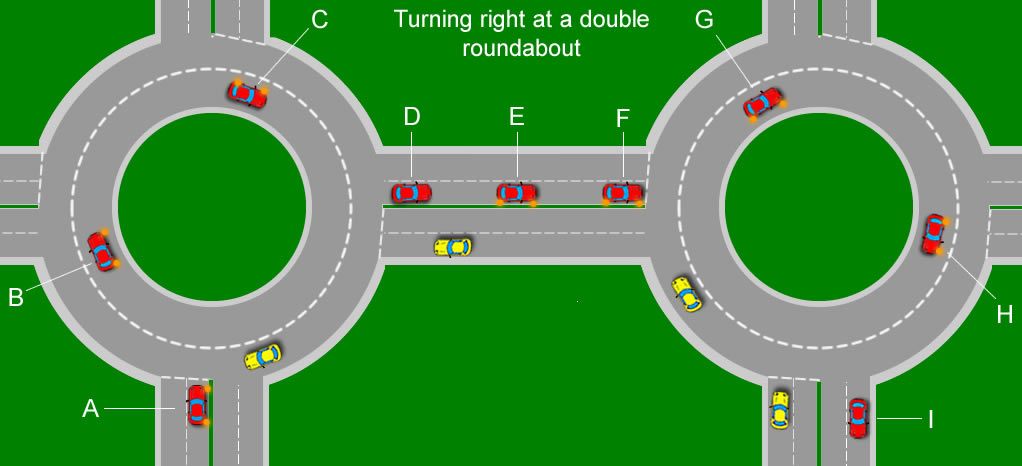
The key to dealing with any double roundabout is to deal with both roundabouts separately.
We’re going to be following the red car which is following the correct driving test procedure for turning right at the double roundabout. As with normal roundabouts, the MSPSL (Mirror, Signal, Position, Speed and Look routine must be applied.
Turning right at a large double roundabout.
- A. Whilst approaching the double roundabout, look into the interior mirror followed by the right mirror, then indicate to the right. Make your way into the right hand lane. If you were previously in the left lane, ensure you check the right blind spot before indicating and before changing lanes.
- B. Give way to the right and when all clear, proceed into the inside right hand lane on the roundabout.
- C. Just after the 2nd exit, look into the interior mirror, followed by the left mirror. You will be changing lanes, now indicate to the left.
- D. As you take the 3rd exit, keep in the right hand lane as you will be turning right at the next roundabout.
- E. Look again into the interior and right mirror and indicate to the right.
- F. Give way to the right.
- G. When clear, enter the roundabout using the right inside lane.
- H. Just after the 2nd exit, look into the interior mirror, followed by the left mirror and the left blind spot and indicate to the left.
- I. When you have taken the 3rd exit, ensure you cancel the indicator.
Mini Roundabouts
Mini-roundabouts. Approach these in the same way as normal roundabouts. All vehicles MUST pass round the central markings except large vehicles which are physically incapable of doing so.
Remember, there is less space to manoeuvre and less time to signal.
Avoid making U-turns at mini-roundabouts. Beware of others doing this.
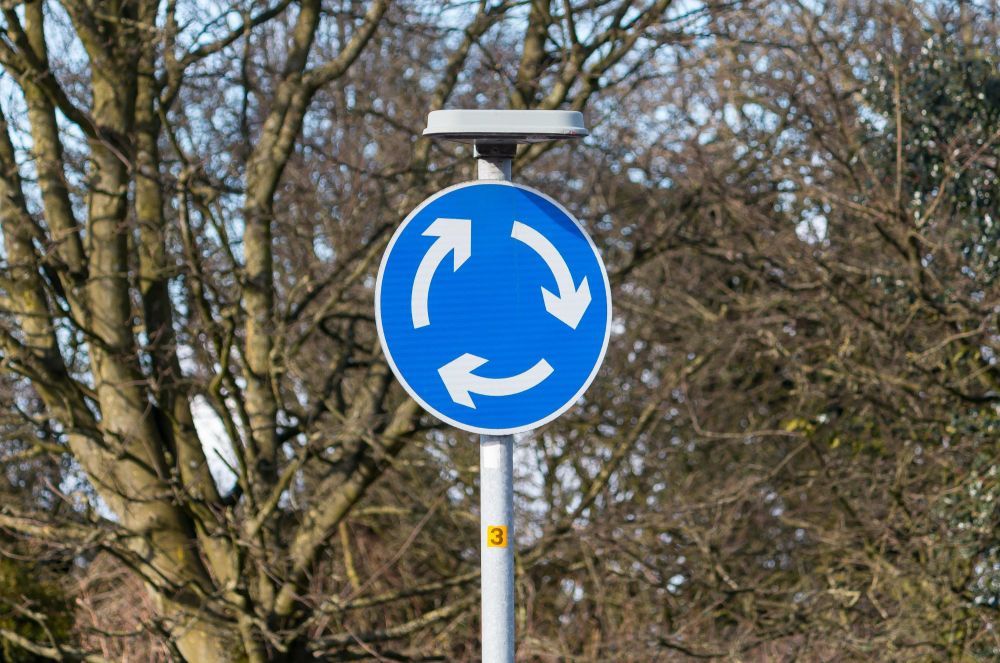
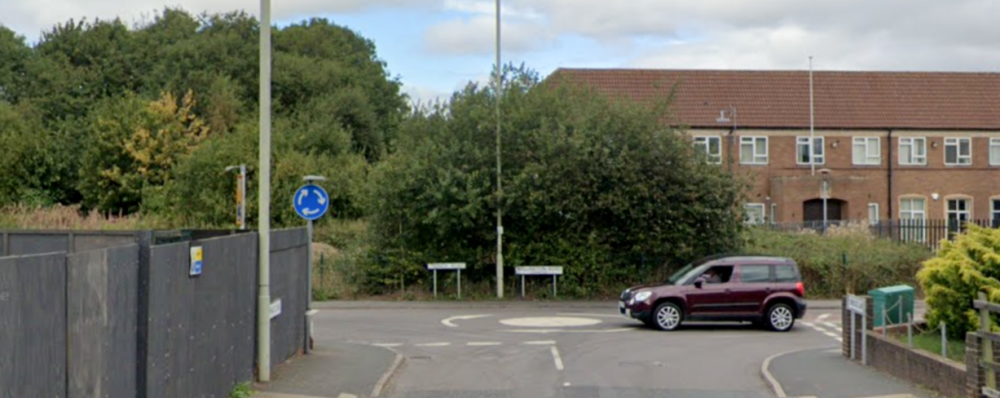
Mini Roundabouts - Open or Closed View?
Open And Closed Mini Roundabouts!
Due to the locations of mini-roundabouts, they have a greater chance of being located at closed junctions.
A closed or blind junction is where very little can be seen of approaching traffic.
Mini roundabouts are used frequently during a driving test for your ability to correctly establish is a junction (or roundabout) is open or closed and to act accordingly. A closed roundabout must be approached very slowly and if in doubt, stop before proceeding. Edge forward using clutch control slowly, constantly checking all exits and entrances.
Right Of Way At A Mini Roundabout!
As with all roundabouts in the UK, drivers approaching a mini roundabout must give way to traffic approaching from the right.
Mini Roundabout And Indicating!
As with normal roundabouts, if turning left or right at a mini-roundabout, an indication must be applied. As mini-roundabouts are small, however, a secondary exit signal does not have to be implemented. On normal roundabouts, vehicles frequently do not indicate, on mini-roundabouts, however, vehicles usually indicate, especially if they intend on turning right. If a vehicle is turning right at a mini-roundabout, due to its small size, it is far too dangerous not to indicate.
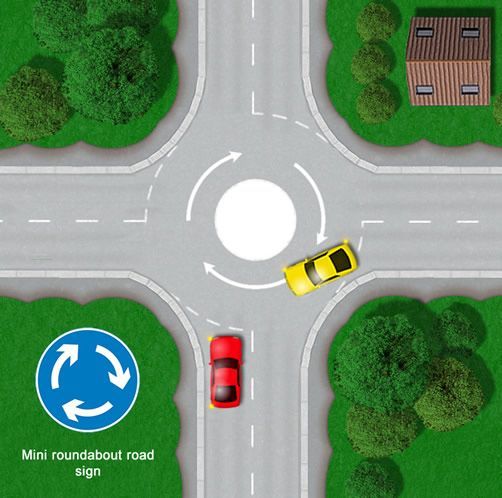
Identifying A Mini Roundabout
Mini Roundabout Road Markings!
The white centre circle of a mini-roundabout can be either simply painted onto the road or it may actually be a circular hump in the road. Whilst navigating a mini-roundabout during a driving test, try to avoid driving on the centre circle.
Although clipping the circle slightly with the wheels is unlikely to fail a test, blatantly driving over the circle is likely to result in a failure.
Try also to avoid driving over any hatch marking lines on or close to the roundabout. These markings are put in place as a safety feature to separate vehicles. Hatchings surrounded by a solid white line must not be crossed, hatchings surrounded by a broken line can be crossed but it is advised not to.
Mini Roundabout U-Turn!
Avoid if at all possible to make U-turns on mini-roundabouts. As they are so small, this manoeuvre is highly dangerous. Locate a safe and quiet road to make a turn in the road or reverse round a corner. Be cautious, especially as an inexperienced driver, that other vehicles may make U-turns at mini-roundabouts.
Mini Roundabout Accidents
Mini Roundabout Accidents!
As mini-roundabouts are so small, it is essential that if you intend on turning right, as you approach a mini roundabout you must indicate to the right. Failure to do so is likely to result in an accident with a vehicle approaching from the opposite direction. Lack of indicating and unnecessarily stopping at a mini-roundabout when vehicles behind you aren’t expecting you to stop are the most frequent cause of mini-roundabout accidents

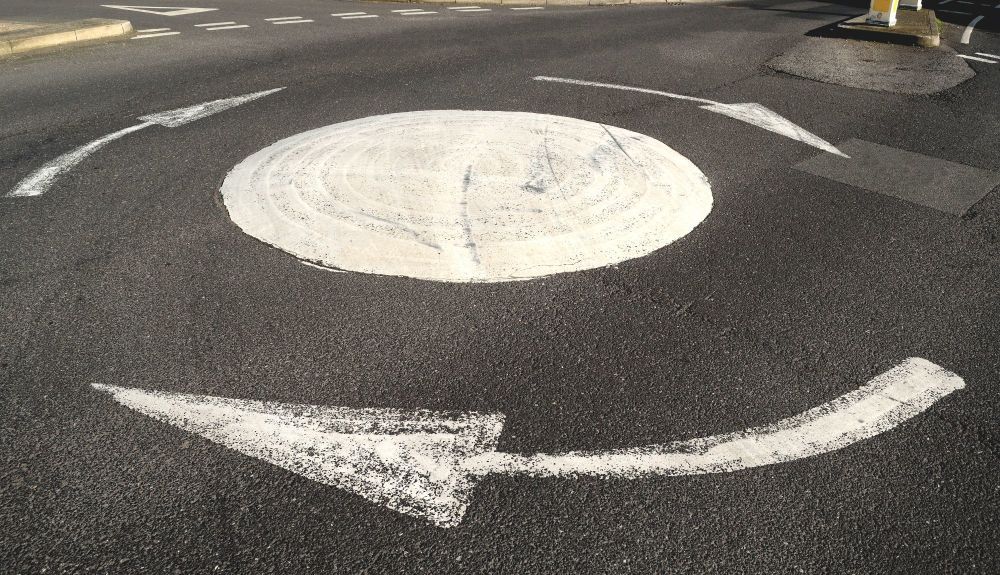
Stopping At Mini Roundabouts
Stopping at Mini Roundabouts!
Unnecessarily stopping at mini-roundabouts is an easy way to fail a driving test. The reason, a vehicle behind you will not be expecting you to stop and so could result in a rear collision accident. If the roundabout is closed or you need to give way to a vehicle or cyclist from the right, this is usually the only reason you should need to stop.
Obviously, mini-roundabouts are small and for a learner driver to see a car approaching the roundabout from the left, can be tempting to stop, especially if the vehicle appears to be traveling at speed. Unless the vehicle is relatively close to the roundabout, is traveling at excessive speed and you feel that they will not be able to stop, don’t be tempted to stop and give way to them. Remember, this is dangerous for vehicles behind and will fail the driving test.
Double Mini Roundabout
Double mini roundabout
Double mini roundabouts can often be found on smaller residential busy roads. A great deal of caution should be applied when approaching to assess what the other traffic is doing. Although double or multiple mini roundabouts may appear confusing, treat each of the roundabouts as individuals.
